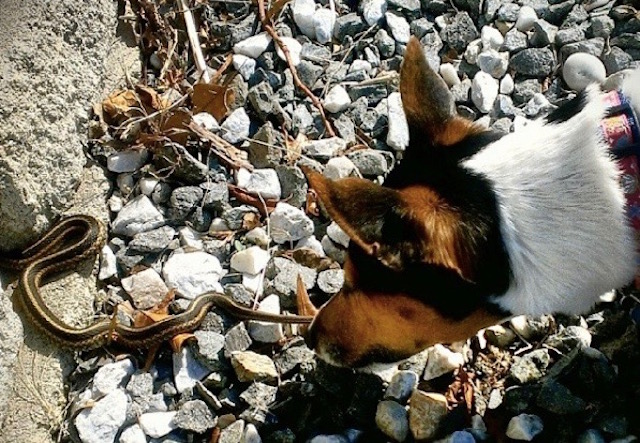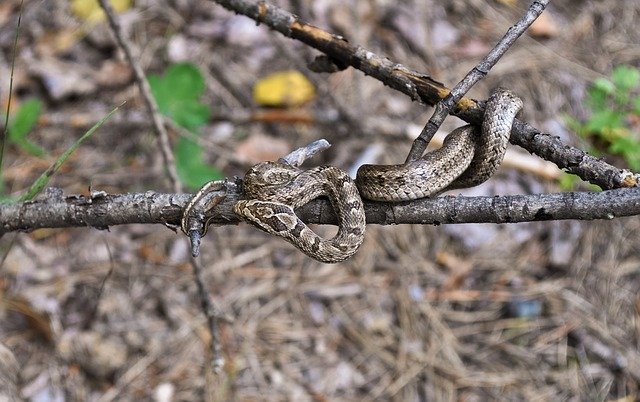Most snakes prefer to avoid dogs. They are shy, cautious, and typically only aggressive when threatened. Still, according to a 2011 veterinary study, nearly 150,000 dogs and cats are bitten each year.
That means these incidents tend to occur when curious pets initiate a confrontation or simply stumble into the wrong place at the wrong time.
Of the world’s 3,000 snake species, only about 600 are venomous, and even fewer are considered a serious risk to pets or people. By following a few simple DOs and DON’Ts you can keep your dog (and yourself) safe from snake bites.

DO: Educate Yourself On The Types Of Snakes In Your Area.
Where you live makes a big difference when it comes to protecting your dog from snake bites. North America is home to 25 venomous snake species including Copperheads, Cottonmouths, Eastern Coral Snakes, and several species of Rattlesnake. Knowing which of these vipers you may encounter is your number one defense against bites.
Learn what the venomous snakes in your area look like, where they make their nests, what they eat, and when they are most active. The more you know about their lifestyle, the easier they will be to avoid.

DON’T: Let Fear Keep You From Having Fun.
Researching venomous snakes can be a sobering experience (trust me, I know!), but you can’t let fear keep you from enjoying the great outdoors with your pup. If you stay vigilant and keep your dog close by your side, you can avoid any close encounters. Which leads us to…
DO: Keep Your Dog On A Short Leash.
Loose dogs left to wander on their own are far more likely to suffer a snake bite than dogs kept on a four-to-six-foot leash. Our pups are curious by nature, and a squirmy, wriggly ground creature is sure to spark their interest.
DON’T: Risk Your Own Safety
Identifying the type of snake that bit your dog can be helpful for your vet, but it is not a necessity. Never risk your own health and safety chasing after or attempting to kill a snake. Your dog needs you safe, calm, and ready to take action, not lost or injured in the woods!

DO: Know The Symptoms Of A Snake Bite.
If your dog has a run-in with the business end of a venomous snake, they will likely yelp and jump back in surprise. You may be able to see puncture wounds on the skin and/or dark, bloody fluid leaking out. Bites are very painful and may cause shock so seek veterinary attention immediately.
Additional signs your dog has been bitten by a snake include:
- Bleeding and bruising of the skin
- Excessive swelling on one area of the body (For example, if the bite is on the paw, the entire lower leg may swell within minutes.)
- Color changes of the skin as tissue death occurs
- Pale gums, cold skin, and shaking
- Weakness, lethargy, confusion and lack of coordination
- Vomiting
- Slow respiration

DON’T: Place A Tourniquet Or Apply Pressure.
Medical professionals once recommended applying pressure to the site of a snake bite to help prevent the spread of venom. These days we know that excess pressure can actually accelerate tissue damage, increasing the pain, and slowing healing.
DO: Keep Your Dog Calm To Slow The Spread Of Venom.
You can help slow the spread of venom through the bloodstream by keeping your dog as calm as possible. Act quickly, but do not panic. Your dog will react to your emotions. If possible, enlist a friend or family member to drive you to the vet. This will free you up to focus on soothing your pooch.
DON’T: Try To Suck Or Squeeze Out The Venom.
Chances are you’ve seen at least one old comedy where one cowboy begs another to suck the venom out of a snake bite. This is just another old wive’s tale for you to avoid. Cutting, sucking, or squeezing the skin around a snake bite will only cause more tissue damage as well as more pain for your pup.

DO: Seek Veterinary Help Immediately.
If you even suspect your dog has been bitten by a snake, get them to the vet as soon as possible! Certain snakes carry powerful neurotoxins in their venom while others carry toxins that attack the circulatory system.
The effects of a venomous snake bite can include paralysis of the muscles – including the heart and diaphragm, destruction of blood vessels, excessive bleeding, excessive clotting, and severe necrosis which could result in the loss of a limb.
Without immediate aggressive care, your dog could die from a venomous snake bite. Watching and waiting is never a good idea.

As scary as this information is, it is important to remember that most snake bites occur when we are infringing on their territory. Do your best to give snakes a wide berth and they will do the same for you!
 Toledo, United States.
Toledo, United States.
